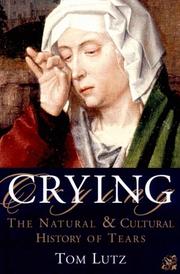| Listing 1 - 10 of 33 | << page >> |
Sort by
|

ISBN: 0393047563 Year: 1999 Publisher: New York Norton
Abstract | Keywords | Export | Availability | Bookmark
 Loading...
Loading...Choose an application
- Reference Manager
- EndNote
- RefWorks (Direct export to RefWorks)
Book
ISBN: 9783205776543 Year: 2009 Publisher: Wien Böhlau
Abstract | Keywords | Export | Availability | Bookmark
 Loading...
Loading...Choose an application
- Reference Manager
- EndNote
- RefWorks (Direct export to RefWorks)
Book
ISBN: 3895640778 Year: 2001 Publisher: Sinzig Studio
Abstract | Keywords | Export | Availability | Bookmark
 Loading...
Loading...Choose an application
- Reference Manager
- EndNote
- RefWorks (Direct export to RefWorks)
Film
Year: 1987 Publisher: Leuven KU Leuven. Audiovisuele dienst [prod., real., dist.]
Abstract | Keywords | Export | Availability | Bookmark
 Loading...
Loading...Choose an application
- Reference Manager
- EndNote
- RefWorks (Direct export to RefWorks)
Infant --- Infant, Newborn --- Crying
Book
ISBN: 0333539974 Year: 1992 Publisher: Basingstoke Macmillan
Abstract | Keywords | Export | Availability | Bookmark
 Loading...
Loading...Choose an application
- Reference Manager
- EndNote
- RefWorks (Direct export to RefWorks)
Crying --- Emotions --- psychology
Dissertation
Year: 1983 Publisher: s. n. Leuven s.n.
Abstract | Keywords | Export | Availability | Bookmark
 Loading...
Loading...Choose an application
- Reference Manager
- EndNote
- RefWorks (Direct export to RefWorks)
Book
ISBN: 0809128403 Year: 1987 Publisher: New York (N.Y.): Paulist
Abstract | Keywords | Export | Availability | Bookmark
 Loading...
Loading...Choose an application
- Reference Manager
- EndNote
- RefWorks (Direct export to RefWorks)
Crying --- Religious aspects --- Christianity
Book
ISBN: 9789004484030 9789051830576 Year: 1988 Publisher: Leiden ;Boston Brill
Abstract | Keywords | Export | Availability | Bookmark
 Loading...
Loading...Choose an application
- Reference Manager
- EndNote
- RefWorks (Direct export to RefWorks)
Book
ISBN: 0472222139 Year: 2024 Publisher: University of Michigan Press
Abstract | Keywords | Export | Availability | Bookmark
 Loading...
Loading...Choose an application
- Reference Manager
- EndNote
- RefWorks (Direct export to RefWorks)
Crying holds a privileged place in conversations around emotions as an expression of authentic feeling. And yet, tears are ambiguous: they might signal the most positive and negative of affects; they might present a sincere revelation of self or be simulated to manipulate others. Unsurprisingly, tears figure prominently on stage and on screen, where actors have experimented with the mechanics of making tears. Cue Tears: On the Act of Crying uses tears as a prism through which to see some of the foundational problems and paradoxes of acting and spectatorship anew, including matters of authenticity and sincerity, the ethics of the witness, the interaction between a speech act and its affective force, liveness and documentation. Across seven semi-autonomous essays, Cue Tears looks at the mechanisms of tear production, internal and external techniques that actors use to weep, and the effects of tears in performance situations on the stage, in the gallery, and in the classroom. The writing moves with a light touch between theory and criticism of a broad range of instances from literature, theater, performance art, visual art, and cinema, while also embracing a strong autobiographical and personal slant. Author Daniel Sack's father was a biochemist who studied tears and collected his son's tears for research during his childhood. These "reflex tears" were produced as a physical response to irritation-an eye stretched past the point of blinking, a cotton swab up the nose. This childhood occupation coincided with his first years taking acting classes, trying to learn how to cry "emotional tears" onstage through psychological stimulation and the recollection of memory. Cue Tears investigates these memories and methods, finding that tears both shore up and dissolve distinctions between truth and artifice, emotional and physical, private and public, sad and humorous.
Crying. --- Tears. --- Acting. --- Sack, Daniel,
Book
ISBN: 9783110201116 3110201119 9786612295928 1282295926 3110214024 9783110214024 9781282295926 6612295929 Year: 2009 Publisher: Berlin ; Boston : De Gruyter,
Abstract | Keywords | Export | Availability | Bookmark
 Loading...
Loading...Choose an application
- Reference Manager
- EndNote
- RefWorks (Direct export to RefWorks)
This volume presents a wide range of contributions that analyse the cultural, sociological and communicative significance of tears and crying in Graeco-Roman antiquity. The papers cover the time from the eighth century BCE until late antiquity and take into account a broad variety of literary genres such as epic, tragedy, historiography, elegy, philosophical texts, epigram and the novel. The collection also contains two papers from modern socio-psychology.
Crying in literature --- Tears in literature --- Classical literature --- Crying --- History and criticism --- Social aspects --- Crying in literature. --- Tears in literature. --- History and criticism. --- Pleurs dans la littérature --- Larmes dans la littérature --- Littérature ancienne --- Pleurs --- Histoire et critique --- Aspect social --- Classical literature - History and criticism. --- Classical literature --History and criticism. --- Crying - Social aspects - Greece. --- Crying - Social aspects - Rome. --- Crying --Social aspects --Greece. --- Crying --Social aspects --Rome. --- Weeping --- Emotions --- Nonverbal communication --- Greek & Latin Languages & Literatures --- Languages & Literatures --- Literature, Classical --- Literature --- Literature, Ancient --- Greek literature --- Latin literature --- Classical literature - History and criticism --- Crying - Social aspects - Greece --- Crying - Social aspects - Rome --- Crying (literature). --- Dacryology (literature). --- Grief (literature). --- Tears (literature). --- Crying. --- Social aspects.
| Listing 1 - 10 of 33 | << page >> |
Sort by
|

 Search
Search Feedback
Feedback About UniCat
About UniCat  Help
Help News
News